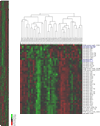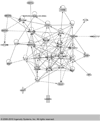Placental microRNA expression in pregnancies complicated by preeclampsia
- PMID: 21093846
- PMCID: PMC3040986
- DOI: 10.1016/j.ajog.2010.09.004
Placental microRNA expression in pregnancies complicated by preeclampsia
Abstract
Objective: The role of posttranscription regulation in preeclampsia is largely unknown. We investigated preeclampsia-related placental microRNA (miRNA) expression using microarray and confirmatory quantitative real-time polymerase chain reaction experiments.
Study design: Placental expressions of characterized and novel miRNAs (1295 probes) were measured in samples collected from 20 preeclampsia cases and 20 controls. Differential expression was evaluated using Student t test and fold change analyses. In pathway analysis, we examined functions/functional relationships of targets of differentially expressed miRNAs.
Results: Eight miRNAs were differentially expressed (1 up-regulated and 7 down-regulated) among preeclampsia cases compared with controls. These included previously identified candidates (miR-210, miR-1, and a miRNA in the 14q32.31 cluster region) and others that are novel (miR-584 and miR-34c-5p). These miRNAs target genes that participate in organ/system development (cardiovascular and reproductive system), immunologic dysfunction, cell adhesion, cell cycle, and signaling.
Conclusion: Expression of miRNAs that target genes in diverse pathophysiological processes is altered in the setting of preeclampsia.
Copyright © 2011 Mosby, Inc. All rights reserved.
Figures




References
-
- Sibai B, Dekker G, Kupferminc M. Pre-eclampsia. Lancet. 2005;365:785–799. - PubMed
-
- Redman CW, Sargent IL. Latest advances in understanding preeclampsia. Science. 2005;308:1592–1594. - PubMed
-
- Huppertz B. Placental origins of preeclampsia: challenging the current hypothesis. Hypertension. 2008;51:970–975. - PubMed
-
- Oudejans CB, van Dijk M. Placental gene expression and pre-eclampsia. Placenta. 2008;29:S78–S82. - PubMed
Publication types
MeSH terms
Substances
Grants and funding
LinkOut - more resources
Full Text Sources
Other Literature Sources

